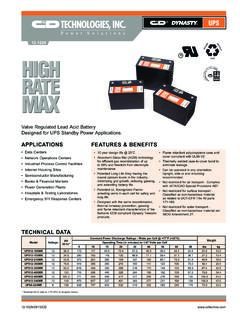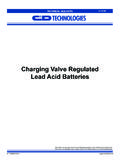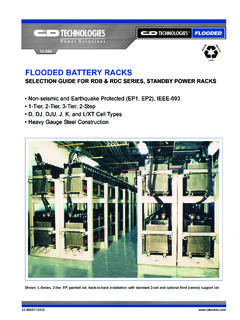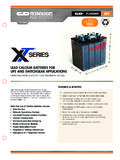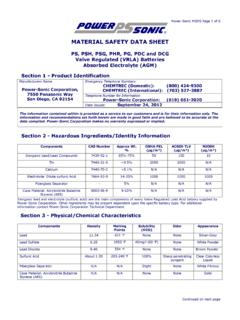Transcription of SAFETY DATA SHEET – L84 - C&D Technologies
1 L84 SAFETY data SHEET L84 Page 1 of 11 1. IDENTIFICATION REVISION DATE: 5/15/2015 Product Name: battery , Electric Storage, Wet, Nonspillable, Not Regulated . NONSPILLABLE Absorbed Electrolyte battery Electrical Storage Valve Regulated Lead-Acid (VRLA) battery Absorbed Glass Mat (AGM) Product Use: Electric Storage battery Manufacturer/Supplier: C&D Technologies , Inc. Address: C&D Technologies , Inc. 1400 Union Meeting Road Blue Bell, PA 19422-0858 Web Sites: North America 24 Hour Emergency Telephone: (CHEM TEL) 1-800-255-3924 International 24 Hour Emergency Telephone: (CHEM TEL) 1-813-248-0585 C&D Technologies Inc. Telephone: 215-619-2700 2.
2 GHS HAZARDS IDENTIFICATION Health Environmental Physical Acute Toxicity (Oral/Dermal/Inhalation) - Category 4 Skin Corrosion/Irritation - Category 1A Eye Damage - Category 1 Reproductive - Category 1A Carcinogenicity (lead) - Category 1B Carcinogenicity (arsenic) - Category 1A Carcinogenicity (acid mist) - Category 1A Specific Target Organ - Category 2 Toxicity (repeated exposure) Aquatic Chronic 1 Aquatic Acute 1 Explosive Chemical, Division GHS Label: Health Environmental Physical Hazard Statements DANGER! Causes severe skin burns and eye damage. Causes serious eye damage. Precautionary Statements Wash thoroughly after handling. Do not eat, drink or smoke when using this product.
3 Wear protective gloves/protective clothing, eye protection/face L84 SAFETY data SHEET L84 Page 2 of 11 May damage fertility or the unborn child if ingested or inhaled. May cause cancer if ingested or inhaled. Causes damage to central nervous system, blood and kidneys through prolonged or repeated exposure. May form explosive air/gas mixture during charging. Extremely flammable gas (hydrogen). Explosive, fire, blast or projection hazard. protection. Avoid breathing dust/fume/gas/mist/vapors/spray. Use only outdoors or in a well-ventilated area. Causes skin irritation, serious eye damage. Contact with internal components may cause irritation or severe burns. Avoid contact with internal acid. Irritating to eyes, respiratory system, and skin.
4 3. *COMPOSITION / INFORMATION ON INGREDIENTS INGREDIENTS (Chemical/Common Names): CAS No.: % by Wt: Lead and Lead Compounds (inorganic) 7439-92-1 50 Sulfuric Acid/ battery Electrolyte sg 40% wt (H2SO4/H2O) 7664-93-9 22 Lead Oxide/Dioxide 1309-60-0 21 Lead Sulfate/Anglesite 7446-14-2 <1 4. FIRST AID MEASURES INHALATION: Sulfuric Acid: Remove to fresh air immediately. If not breathing, give artificial respiration. If breathing is difficult, give oxygen. Consult a physician. Lead: Remove from exposure, gargle, wash nose and lips; consult physician. INGESTION: Sulfuric Acid: Give large quantities of water; Do NOT induce vomiting or aspiration into the lungs may occur and can cause permanent injury or death; consult physician.
5 Lead: Consult physician immediately. SKIN: Sulfuric Acid: Flush with large amounts of water for at least 15 minutes; remove contaminated clothing completely, including shoes. If symptoms persist, seek medical attention. Wash contaminated clothing before reuse. Discard contaminated shoes. Lead: Wash immediately with soap and water. EYES: Sulfuric Acid and Lead: Flush immediately with large amounts of water for at least 15 minutes while lifting lids; Seek immediate medical attention if eyes have been exposed directly to acid. L84 SAFETY data SHEET L84 Page 3 of 11 5. FIRE FIGHTING MEASURES Flash Point: Not Applicable Flammable Limits: LEL = (Hydrogen Gas in air); UEL = Extinguishing media: CO2; foam; dry chemical.
6 Do not use carbon dioxide directly on cells. Avoid breathing vapors. Use appropriate media for surrounding fire. Fire Fighting Procedures: Use positive pressure, self-contained breathing apparatus. Beware of acid splatter during water application and wear acid-resistant clothing, gloves, face and eye protection. If batteries are on charge, shut off power to the charging equipment, but note that strings of series connected batteries may still pose risk of electric shock even when charging equipment is shut down. Hazardous Combustion Products: Highly flammable hydrogen gas is generated during charging and operation of batteries. If ignited by burning cigarette, naked flame or spark, may cause battery explosion with dispersion of casing fragments and corrosive liquid electrolyte.
7 Carefully follow manufacturer's instructions for installation and service. Keep away all sources of gas ignition and do not allow metallic articles to simultaneously contact the negative and positive terminals of a battery . Follow manufacturer's instructions for installation and service. 6: ACCIDENTAL RELEASE MEASURES Stop flow of material, contain/absorb small spills with dry sand, earth or vermiculite. Do not use combustible materials. If possible, carefully neutralize spilled electrolyte with soda ash, sodium bicarbonate, lime, etc. Wear acid-resistant clothing, boots, gloves, and face shield. Do not allow discharge of un-neutralized acid to sewer. Acid must be managed in accordance with approved local, state, and federal requirements.
8 Consult state environmental agency and/or federal EPA. 7. HANDLING AND STORAGE Handling: Unless involved in recycling operations, do not breach the casing or empty the contents of the battery . Handle carefully and avoid tipping, which may allow electrolyte leakage. There may be increasing risk of electric shock from strings of connected batteries. Keep containers tightly closed when not in use. If battery case is broken, avoid contact with internal components. Keep vent caps on and cover terminals to prevent short circuits. Place cardboard between layers of stacked automotive batteries to avoid damage and short circuits. Keep away from combustible materials, organic chemicals, reducing substances, metals, strong oxidizers and water.
9 Use banding or stretch wrap to secure items for shipping. Storage: Store batteries under roof in cool, dry, well-ventilated areas separated from incompatible materials and from activities that may create flames, spark, or heat. Store on smooth, impervious surfaces provided with measures for liquid containment in the event of electrolyte spills. Keep away from metallic objects that could bridge the terminals on a battery and create a dangerous short-circuit. L84 SAFETY data SHEET L84 Page 4 of 11 Charging: There is a possible risk of electric shock from charging equipment and from strings of series connected batteries, whether or not being charged. Shut-off power to chargers whenever not in use and before detachment of any circuit connections.
10 Batteries being charged will generate and release flammable hydrogen gas. Charging space should be ventilated. Keep battery vent caps in position. Prohibit smoking and avoid creation of flames and sparks nearby. Wear face and eye protection when near batteries being charged. 8. EXPOSURE CONTROLS / PERSONAL PROTECTION Exposure Limits (ug/m3) Note: = Not Established INGREDIENTS (Chemical/Common Names): OSHA PEL ACGIH US NIOSH Quebec PEV Ontario OEL EU OEL Lead and Lead Compounds (inorganic) (b) Sulfuric Acid/Electrolyte (H2SO4/H2O) 1 1 1 (c) Lead Oxide/Dioxide (b) Lead Sulfate/Anglesite (b) (a)As dusts/mists (b)As inhalable aerosol (c)Thoracic fraction Engineering Controls (Ventilation): Store and handle in well-ventilated area.
